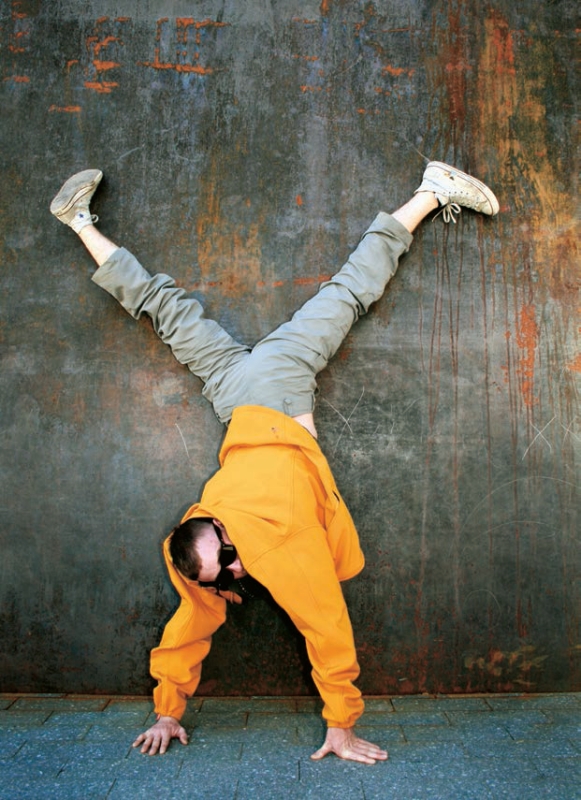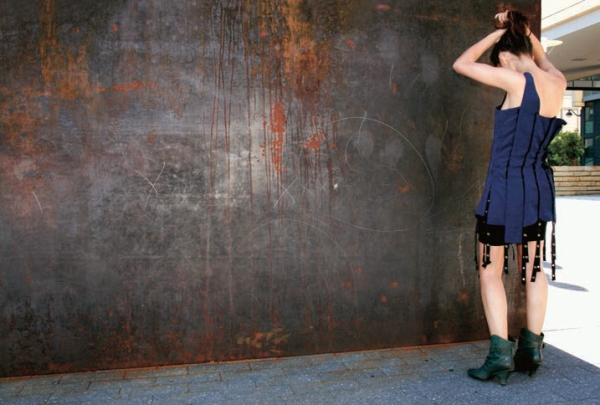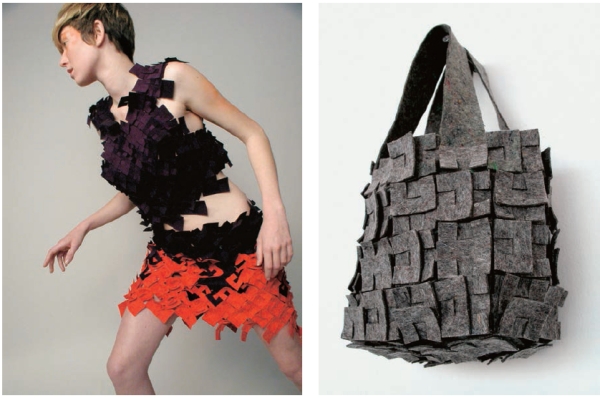Chapter 6: Adaptability
ADAPT:
1. To make fit or suitable by changing or adjusting.
2. To adjust (oneself) to new or changed circumstances; vi to adjust oneself 4
In design for sustainability, adaptability in product, process or system is most often a response to inefficient use of resources in the commercial fashion industry. Strategies of adaptability seek to intensify use so as to increase the efficiency with which each garment is worn – to get more output from the same input. Taken individually, this can allow us to do more with a single garment, though it is also part of a bigger body of work that begins to interrupt the larger cycles of purchase and discard, ultimately to slow consumption overall, and to challenge prevailing business models that depend on producing and selling large volumes of garments in order to benefit from large economies of scale that maximize profits.
In nature, the adaptability of life to its environment is the primary driver for the evolutionary process by which new biological species arise, and is the foundation from which all life flows. Adaptability allows certain species to occupy specific niches within the habitat, each with a unique opportunity for interaction with other species, resources and processes.5 The openness and readiness of a species to adapt enables it to flex and shift continually in response to changing conditions and to survive in hostile environments. This continual change on a micro scale is underpinned by the stability and resilience of an ecosystem on a macro scale, enabling it to respond and remodel itself in the face of crisis in one area while remaining steady in others.
Adaptability in a business context
For industries, corporations and large businesses, adapting is a cumbersome and slow process – sheer inertia inhibits their ability to flex and change. People working to implement sustainability-focused practices in the current fashion industry often feel the weight of this immobility on a daily basis, and the inability of the fashion industry to adapt is one of the key reasons that sustainability in fashion has remained in roughly the same territory (of product and process improvement) for the past 20 years. As sustainable-design thinker Jonathan Chapman states: ‘The system itself tends to edit out innovation in favour of ideas that are useful and convenient to the established mode of operation.’6 What innovative thinking is edited out in industry and in product development is also edited out in the designer, the wearer and the market. For all have themselves adapted to the prevailing pattern of operation: large volumes and homogenous products rolled out and available across global markets.
It follows then that variety and pluralism in the form of adaptable fashion products are not only challenging for industry, but also for designers and consumers, transforming the way all stakeholders create and experience fashion. For industry, and particularly that segment used to designing large volumes of similar products for mass-manufacture, the challenge of adaptability is to foster heterogeneity in thinking and garment design that accommodates varying circumstances. For wearers, adaptability often necessitates a more hands-on role in morphing a piece from one form to another. And for designers, adaptability brings a change of focus from designing a finished garment to creating a work in progress, a changing, growing, transforming piece.
Just as niches in nature have a symbiotic relationship with the larger ecosystem, so this incubation of alternative industrial, consumer and design behaviours influences the metabolism of our industry as a whole. Adaptability can be seen to provide a means to fulfil the end user’s desire for variety and to optimize material productivity. But through its focus on transformation and flexibility, adaptability also has the potential to increase the industry’s resilience over the long term and to better prepare us for a time when change and heightened risk – physical, economic, ecological and social – is the order of the day.
Trans- and multiple functions
Adaptability can manifest itself in many forms, for there are multiple attributes that comprise a product. Colour, silhouette, texture, pattern, function and detail all offer opportunities for manipulation and transformation. And each challenges the status quo of industrial fashion to a greater or lesser degree. Transfunctional adaptability is fully embedded within the materiality of the product and is often inspired by ideas of biomimicry (see Chapter 11), where nature’s efficiencies provide complex yet elegant solutions or accommodate the stacking of one function within another. Because transfunctional attributes are usually invisible, the garments suit our modern lifestyle well, for when speed and convenience are paramount, invisible qualities easily accommodate swift movement from one social setting or environmental condition to another, and make few demands on the wearer to slow down or stop to adjust a garment physically. What transfunctional items provide in convenience, then, they lack in engagement, for the invisible attributes remain unexperienced in any overt or even covert form; transfunctional garments do not ask us to question or change our behaviour. And it is precisely because they are not challenging on this level that transfunctional items are the most commercially accepted form of adaptability.
Transfunctional garments
When one transfunctional garment replaces several other garments, as is the intention, with items made from, say, waterproof, insulating yet breathable fabrics, the concept offers high potential to dematerialize our wardrobes and increase the number of wearing hours per item of clothing. However, if the end user’s behaviour remains unstudied, there is no guarantee that the sustainability savings made on a single transfunctional product will not be lost on an additional purchase. So, though transfunctional items bring promise for reduction in resource and energy use, still, influencing consumer behaviour and the growth model of commerce remain the key challenges. US outdoor sportswear company REI has developed a jacket that provides warmth, water protection and breathability. The high-tech fabric attributes mean that it can replace three layers of clothing (insulating layer, wind barrier and waterproof layer) with one and still meet the needs of the wearer in all three function categories. The garment illustrates how a strategy of transfunction expressed in fabric or garment form can potentially influence larger scales, affecting the choices in a whole outfit and even a complete wardrobe.

REI’s jacket combines the functions of insulation, windproofing and waterproofing in one.
Multifunctional garments
Humans are moody and emotional, fickle and erratic, and live in a society that has shifting values and evolving beliefs. Though fashion itself evolves over the long term to reflect society and culture, industrially produced products, even when they are transfunctional, are physically static. Multifunction garments go some way towards addressing this inertia by building a more robust and resilient relationship between product and wearer courtesy of multiple levels of engagement. This holds the promise of increasing the number of wearing hours per garment. However, designers are notoriously delighted with their own inventions and the ability to create functions can frequently override the need for them in the first place! Moreover, an arbitrary excess of features can create confusion in the end user and intimidate to the point where functions beyond basic utility are seldom used. ‘Rigors of restraint’7 in design are therefore essential and are particularly important when multifunction is employed as a strategy to reduce environmental impact, for when each additional feature requires more natural resources, or when wearer consternation results in a discarded garment, the actual outcome is the antithesis of sustainability.
Multifunction as an end in itself, then, can completely miss the point of sustainability – especially when features can and often do become novelties or lures to purchase more. But when multifunction is handled well, when the intended use of each feature is clear and the desired behavioural outcome is effectively afforded through well-designed mapping and clues, it has the potential to transform a static product into one that engages the wearer through a number of moods and physical needs. Well-designed mechanisms for multifunctional use can intercept the familiar, repetitive act of getting dressed and start to shape the mind to new ideas, laying the groundwork from which greater changes can be generated. The reversible Cambia T-shirt made by Páramo, for example, is designed to wick away moisture and has two fabric faces, each of which can be worn inside or out depending on external factors and the needs of the wearer. When worn next to the skin, the smooth fabric face keeps moisture close to the body, helping to keep it cool in warm conditions. When reversed, the honeycomb face directs water away from the skin, keeping the body drier and warmer. While each function is continuously present in the fabric, the fact that wearers have to stop, consider the conditions, weigh their own needs, and turn the T-shirt one way or the other, subtly engages them beyond surface styling and starts to cut new grooves of behavioural change towards sustainability.
Trans-seasonal
Fashion thrives on change and speed and the cycling of garments through an individual’s wardrobe. To ensure product turnover and additional purchases, the fashion industry has manufactured artificial retail ‘seasons’ that require new looks and styles. Participation in these man-made seasons carries a social coding, a sense of doing well, being able to stay up on the latest trends and afford frequent purchases: Back to School, Transition, Cruise and Holiday are just a few of the calls to lure consumers to shopping malls. All are designed to tempt a change in wardrobe components and to ensure the continuous flow of goods through the industrial fashion system.
Trans-seasonal garments
Trans-seasonal garments have the potential to intercept this dominant industry logic. Rather than developing new colour palettes and silhouettes every few weeks, designers identify colours that will work across different seasons and wardrobe combinations. Trans-seasonal concepts start to engage designers and wearers too on levels extending beyond the material aspects of fashion and into the immaterial – connecting both to the rhythms of natural seasons, and demanding that each consider what degree of change is necessary and for what reasons. This will include, from the perspective of the wearer, which parts of the body need protection and warmth and when; and from a designer’s standpoint, what degree of adaptation will engage the consumer to slow or intercept additional purchases.

Emily Melville’s coat combines an under-jacket and a waistcoat that can be worn together or separately to serve in different seasons.
The organic shapes in Emily Melville’s coat were inspired by researching which areas of the body most needed warmth. The under-jacket wraps around the core of the body, where functional warmth is most critical, yet it is also integrated with the sleeves to form an interestingly shaped design in itself. The long, sleeveless waistcoat is designed to be worn alone or layered over the jacket. Equally strong together or apart, the items can be worn in combination in cooler weather conditions and separately in warmer seasons.
Modular
Modular garments allow for the playful and creative engagement of the wearer and have the potential to bring a long-lasting sense of delight by being adaptable to personal preference and needs. Designing modular garments for adaptable assembly and use demands more of the designer, for he or she has to accommodate and facilitate the individual expression of the wearer. The designer’s intent shifts from developing a resolved product to developing a resolved concept, and the design genius becomes the system or mechanism of assembly and disassembly as much as the product itself. Modular garments therefore broaden the design lens beyond a garment to include consumer behaviour, purchasing habits, social coding and signals and help us to treat complex sustainability problems with complex solutions. Modular garments not only offer alternative ways to consume, but also demand new business models, where pieces of garments are made as readily available as full garments or collections; these models are built less upon volume of material throughput and more on services, cycles and underlying human needs (see Chapter 13).

DePLOY’s approach to modularity is based on traditional tailoring and convertible outfits.
DePLOY’s approach to modularity considers the whole outfit. Aiming to ‘fit the largest wardrobe into the smallest suitcase’, each piece in DePLOY’s collection is adaptable and open to personalization – a dress becomes a skirt, or a coat becomes a dress – through old-school clever tailoring and the snap of an imperceptible fastening. A single outfit thereby offers numerous possibilities, enabling customers to make more out of less by replacing new fashion garment ‘parts’ each season. Designing to dematerialize a wardrobe while at the same time fulfilling the social needs of busy, active, modern women means that the function of the outfit across a variety of social contexts has to be considered from the outset. The style of DePLOY’s garments spans from the office to dinner and onwards, with the innovation being in the transformational properties of the outfits achieved with as few parts as possible. DePLOY’s business model is reflected in its philosophy – ‘a place to create, not just to consume’ – and in its description of its modular line as ‘demi-couture’.
Besides requiring us as designers to re-examine modes of practice and business, modularity in clothing also offers us a means to reflect on how we as wearers refresh our wardrobes and, in a way, refresh ourselves. It asks if we can fulfil our desire for something new by adapting an existing garment and how radical such changes need to be to satisfy the basic human need for cyclical variety. Responding to this line of enquiry, Crystal Titus designed a modular dress around a system of snaps, which enables panels to be easily disconnected and reconnected. This flexible construction allows sections to be replaced with other colours, fabrics and prints and also to be moved vertically against each other to vary the neckline shape. Manon Flener’s jacket follows a similar train of thought, yet results in a different look. With metal studs as the means of attachment, the removable garment pieces are comprised of durable fabric squares, resulting in a much more ornamented final product.
Each of these modular concepts could be developed further. Research tracking the patterns of use and degrees of boredom within various product categories and types could yield a collection of items exhibiting various levels of modularity, reflecting the appropriate need for and speed of cyclical variety in each item. These ruminations illustrate the way in which, once the design mind has adapted to a way of thinking that flows from a starting point based on sustainability principles, ideas will self-generate and build upon each other, forming various paths for fashion and clothing development.
Changing shapes
Of all the adaptability concepts presented in these pages, changing the silhouette or shape of a garment is perhaps the most challenging on all levels, for shape literally forms the physical parameters and boundaries within which fashion designers work and defines the space in which the wearer moves. Yet designing to accommodate changes in product shape is a concept that has been successfully applied to children’s toys such as Lego, Meccano and Tinker Toys for many years. What these games have in common is a simple and specific system for fastening components together that, once learned, can be manipulated into various levels of complexity. They allow for individual interpretation, and leave space for intuition and for the continuous integration of skill-building, aesthetic enchantment and playfulness. What’s more, they provide the means for players to explore and to build for themselves.

Modular Dress by Crystal Titus allows panels to be removed and replaced using a snapping system.

Modular jacket by Manon Flener created from square sections attached by studs.
Garments that change shape
Designing for changing shapes demands a completely different logic across all sectors of the fashion industry. The designer has to acquire knowledge of radically different construction and pattern-making techniques and recognize the creative abilities and limits of the end wearer. The wearer in turn has to be confident enough to involve herself in the continuing evolution of the product and be prepared to embrace a completely new approach to clothing the body. Changing shapes also reshapes the relationship between the designer and the wearer: both become actively responsive to the other, in a markedly different way than when focused solely on the sale and the purchase of a static piece of clothing. Ironically, as both designer and wearer become more engaged with each other, they also become less attached – the designer less attached to his or her own ideas, allowing the final form of the garment to emerge in the hands of the wearer, and the wearer less attached to things, for as a new shape is built the previous one disappears. In this way, designing for evolving shapes provides another means by which to bring products from flows into cycles. It helps us appreciate a wider set of values beyond the physical artefact and to style and clothe ourselves in ways that most closely mimic natural systems such as growth and decay, and expansion and contraction.

The interlocking die-cut felt squares in Galya Rosenfeld’s pieces provide many possibilities to create different forms.
Conceptual fashion designer Galya Rosenfeld develops and builds shape-shifting garments and bags as a series of ‘pixels’ or squares that interlock on all four sides. Die-cut from felt, these self-finished sections allow for easy assembly by hand, with no refined skills, special equipment or energy sources required. Overall, the concept provides an almost infinite variety of construction possibilities and a means for the wearer to fulfil the emotional desire for variety and change, and even accommodates complete disassembly and reassembly into entirely new products. Changing shapes is the ultimate challenge for industrial fashion, for how might it adapt to accommodate garments that disappear and reappear in the hands of the wearer?
